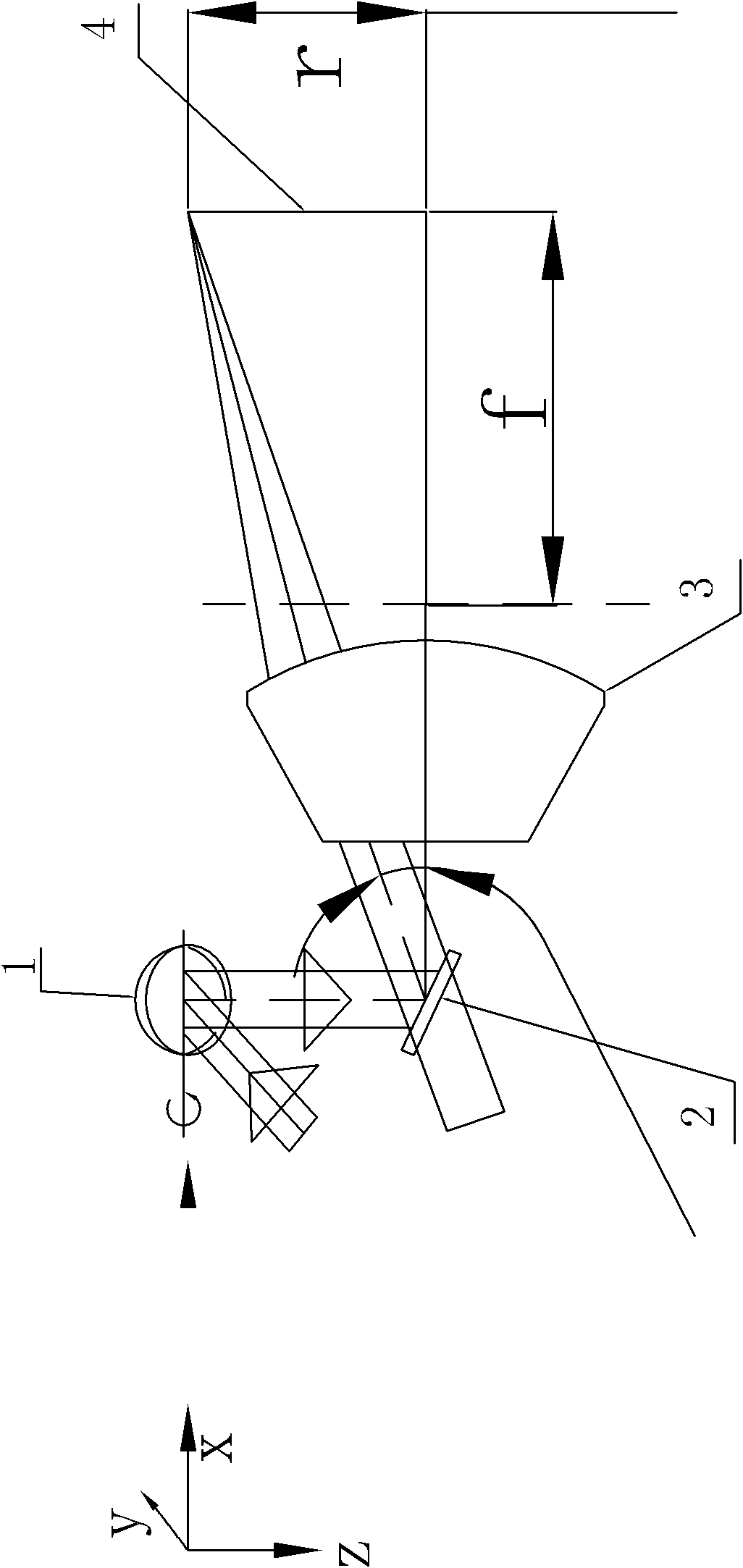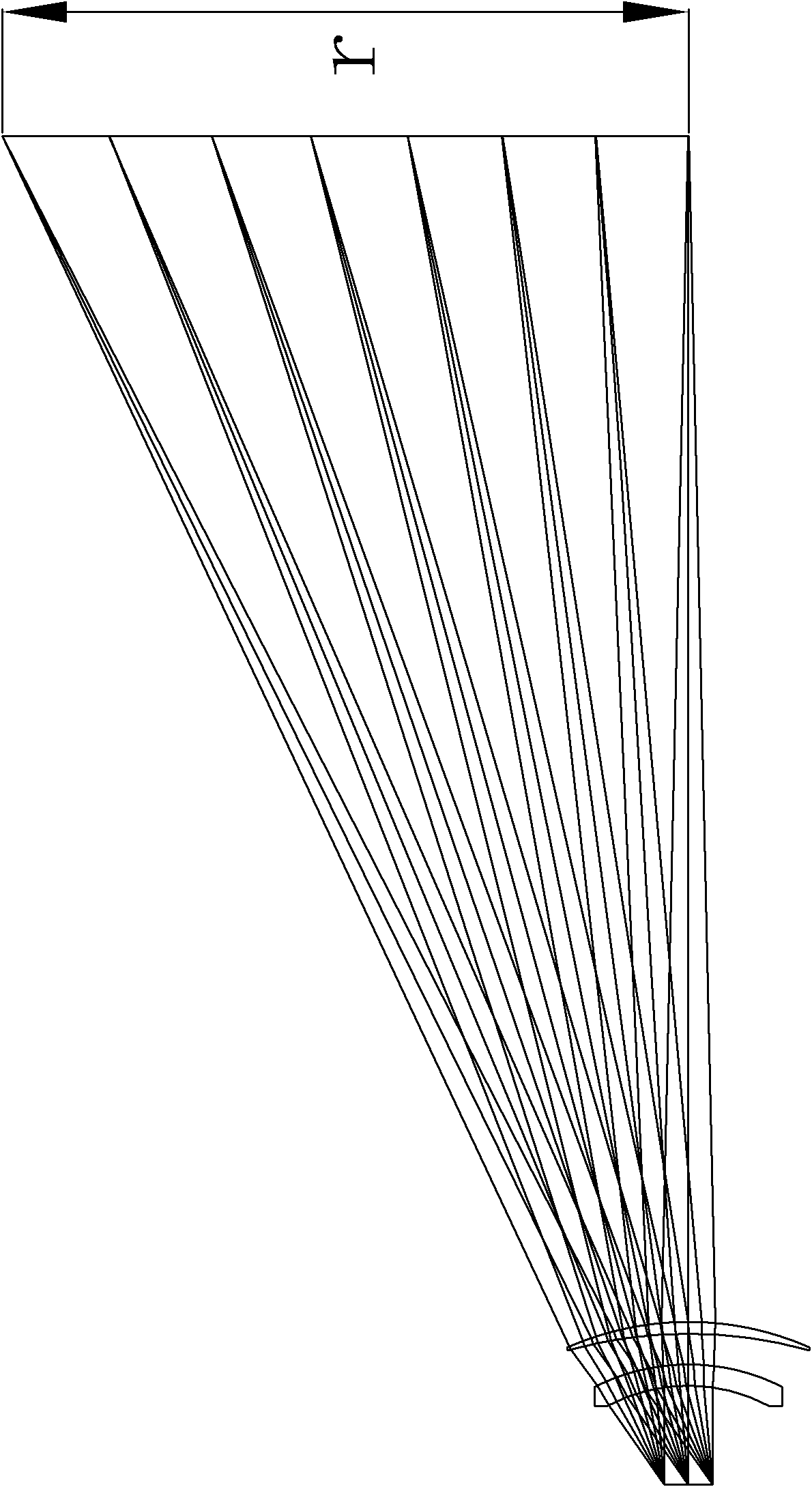F-theta lens and optical system
An optical system and lens technology, applied in the field of optical lenses, can solve the problems of limited scanning range of the lens and difficult aberration correction, and achieve the effect of improving the scannable range, small focusing spot, and expanding the application range.
- Summary
- Abstract
- Description
- Claims
- Application Information
AI Technical Summary
Problems solved by technology
Method used
Image
Examples
Embodiment 1
[0014] Example 1, as figure 2 As shown, the present invention provides a two-piece F-theta lens, which includes a first lens L1 and a second lens L2 arranged in sequence along the direction of incident light, and the first lens L1 is a meniscus negative lens , the second lens L2 is a meniscus positive lens, the curved surfaces of the two lenses are curved toward the incident direction of the light; the field angle of the lens is 2ω=70°, the light entrance aperture is 30mm, and its scanning range is 608mm×608mm.
[0015] In this embodiment, the focal length of each lens and the system focal length of the F-theta lens respectively satisfy:
[0016] -1.2
[0017] 0.5
[0018] Wherein, f1 is the focal length of the first lens, f2 is the focal length of the second lens, and f is the system focal length of the F-theta lens.
[0019] Preferably, the focal length of each lens and the system focal length of the F-theta lens further satisfy: f1 / f=-1.168; f2 / f=0.597....
Embodiment 2
[0022] Embodiment 2, under the condition that the above conditions are met, the present invention further provides an embodiment.
[0023] like figure 2 As shown, the first lens L1 includes two curved surfaces S1 and S2 with radii of curvature R1 and R2 respectively, and their central thickness is d1, where R1=-108.029mm, R2=-128.433mm, and d1=13.288mm; the second The lens L2 includes two curved surfaces S3 and S4 with radii of curvature R3 and R4 respectively, and the central thickness thereof is d3, where R3=-277.299mm, R4=-188.451mm, and d3=7.441mm; the second lens L2 and the imaging surface The distance on the optical axis is d4, and d4 is 743.3mm. The distance between the first lens L1 and the second lens L2 on the optical axis is d2, and d2 is 19.271 mm.
[0024] Further, both the first lens L1 and the second lens L2 are made of ZnSe.
[0025] The above specific structural parameters are as follows:
[0026]
[0027] Note: Negative numbers mean that the center of...
Embodiment 3
[0028] Embodiment 3, on the basis of Embodiment 1 or Embodiment 2, provides an optical system, such as figure 1 , 2 As shown, it includes a galvanometer system that can be rotated around the X-axis and the Y-axis and guides the light beam to scan at the F-theta lens 3, wherein the galvanometer system includes a first galvanometer 1 and a second galvanometer 2, and the F-theta lens 3. It includes a first lens L1 and a second lens L2 arranged in sequence along the light propagation direction, the first lens L1 is a meniscus negative lens, the second lens L2 is a meniscus positive lens, and the curved surfaces are all facing the light incident direction Curved; the field of view of the lens is 2ω=70°, the light entrance aperture is 30mm, and its scanning range is 608mm×608mm.
[0029] The focal lengths of the first and second lenses respectively satisfy the system focal length of the F-theta lens:
[0030] -1.2
[0031] 0.5
[0032] Wherein, f1 is the focal l...
PUM
 Login to View More
Login to View More Abstract
Description
Claims
Application Information
 Login to View More
Login to View More - R&D
- Intellectual Property
- Life Sciences
- Materials
- Tech Scout
- Unparalleled Data Quality
- Higher Quality Content
- 60% Fewer Hallucinations
Browse by: Latest US Patents, China's latest patents, Technical Efficacy Thesaurus, Application Domain, Technology Topic, Popular Technical Reports.
© 2025 PatSnap. All rights reserved.Legal|Privacy policy|Modern Slavery Act Transparency Statement|Sitemap|About US| Contact US: help@patsnap.com



